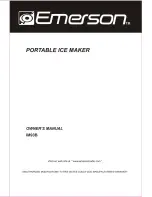
Symptom
Cause
Remedy
The bread rises too much.
The amount of sugar is excessive.
Reduce the amount of sugar.
The amount of yeast is excessive.
Reduce the yeast to a proper level.
A business-use flour with too much protein has
been used.
Reduce the amount of yeast.
The amount of flour and water is excessive.
Measure the correct amount with a measuring
cup.
The bread maker is used at elevations of 1.000m
or above.
Reduce the amount of yeast.
The bread does not rise high and remains
white.
The kneading blades are not attached.
Attach the kneading blades.
The user forgot to add the yeast.
Be sure to place the yeast under the flour.
The amount of water is excessive.
Measure the correct amount with a measuring
cup.
The amount of flour is insufficient.
Measure the correct amount with a measuring
cup.
Put the water in first
Add the yeast, flour and water in that order.
Some flour is left inside the bread.
The amount of flour is excessive.
Measure the correct amount with a measuring
cup.
The amount of water is excessive.
Note:
Making bread is a very delicate task. Even if you follow the same procedure to bake, the rising and shape of the bread varies depending on
the room temperature, ingredients, preservatives, and the use of the timer. Temperature differences between the morning, noon, and night or
using an air conditioner greatly affects the bread.
Also, the kind of ingredients, their freshness, the amount of protein in the flour and the preservatives affect the height and rising of the bread.
·
Use the bread maker at a room temperature of no more than 30°C.
·
When the room temperature is 25°C or higher, use cool water and decrease the amount of water by 10ml. (It is better to cool the flour in
the refrigerator.)
·
Place the yeast under the flour to prevent contact with the water.
·
Measure the correct amount with a measuring cup and a scale. Add the yeast, flour, water, and other ingredients in this order.
·
Use new ingredients (yeast, flour, sugar, etc.) and put the remaining yeast into a sealed package to be stored in a refrigerator.
* Be sure to set dry ingredients in the dispenser. (Sticky materials make the dispenser assembly dirty and can cause a malfunction of the
open/close operation.)
10
SD-253
Summary of Contents for Bread Bakery SD-253
Page 2: ...1 Operating Instructions 2 SD 253 ...
Page 3: ...3 SD 253 ...
Page 4: ...4 SD 253 ...
Page 5: ...5 SD 253 ...
Page 6: ...6 SD 253 ...
Page 7: ...7 SD 253 ...
Page 23: ...5 1 Parts Location ENG 5 REPLACEMENT PARTS ENG 23 SD 253 ...
Page 25: ...6 REPLACEMENT PARTS GER 6 1 Parts Location GER 25 SD 253 ...
Page 27: ...7 REPLACEMENT PARTS BEL 7 1 Parts Location BEL 27 SD 253 ...
Page 29: ...8 1 Parts Location RSA 8 REPLACEMENT PARTS RSA 29 SD 253 ...
Page 31: ...9 REPLACEMENT PARTS AUST 9 1 Parts Location AUST 31 SD 253 ...
Page 33: ...10 REPLACEMENT PARTS NZL 10 1 Parts Location NZL 33 SD 253 ...











































